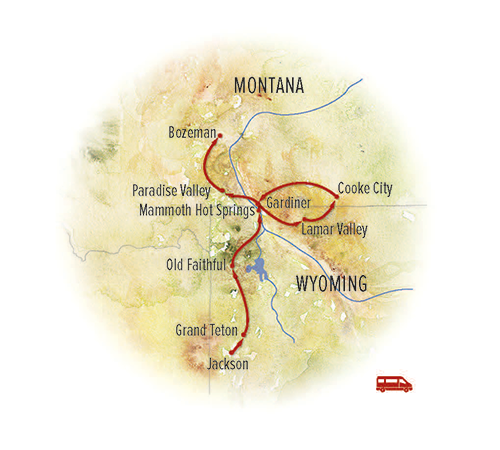Itinerary
Day 1: Jackson, Wyoming
The Old West town of Jackson sits on the edge of Grand Teton National Park. While retaining its cowboy flavor, Jackson hosts guests with plenty of contemporary panache. We spend the first night of our Yellowstone safari tour here, meeting our Expedition Leaders and fellow adventurers at a welcome dinner this evening.
Nothing quite prepares you for the drama of the Grand Tetons, which rear up in a row of pointed peaks from the floor of Jackson Hole. Protected forever in one of America’s most impressive national parks, the Tetons are emblems of the West’s wild majesty. Grand Teton's wildlife is as magnificent as its mountains, and we may see elk, pronghorn antelope, mule deer, bison and eagles as we traverse the park today in our specialty North American Safari Trucks. With large windows, leather bucket seats with charging points, and a pop-top roof that lifts completely up for a 360° view on the landscape, these custom vehicles are designed for optimal wildlife viewing. This afternoon, water level permitting, float the placid Snake River beneath the jagged backdrop of the Tetons, looking out for moose, beaver, osprey, pelicans, or even a black bear near the river’s edge.
Day 3: Oxbow Bend / Yellowstone National Park—Old Faithful
Moose are our objective this morning as we search the willow-covered bottomlands of Oxbow Bend just east of Jackson Lake. The slow-moving water provides habitat for fish that are food for other wildlife, and we may spy river otter, beaver, muskrat, osprey, bald eagles and American white pelicans. Continuing north to enter Yellowstone, the world’s first national park, established in 1872, we get our first glimpse of the geothermal features that dot the landscape. From bubbling mud pots to eruptions of boiling water rocketing skyward, Yellowstone’s geyser areas are one of the unique features that captivated early explorers like John Colter and Jim Bridger and prompted conservationists like Teddy Roosevelt to encourage protection of the park’s natural assets. We also learn about fire ecology as we drive through recovering areas once ravaged by wildfires. At Old Faithful this afternoon, there’s ample time to see the famous geyser erupt and to walk among the fumaroles and hot springs nearby.
Day 4: Hayden Valley / Grand Canyon of the Yellowstone / Lamar Valley / Gardiner
Much more of the park lies ahead, including Hayden Valley, a favored grazing area for large herds of bison and elk. Yellowstone is home to some 4,000 bison, the largest land mammals in North America, which we expect to encounter today. Bighorn sheep may be on display near Mount Washburn, and we may also spot coyotes and bald eagles. A stop at the Grand Canyon of the Yellowstone, where Yellowstone Falls pours off a sheer cliff into a thousand-foot-deep gorge, offers the park’s most inspiring vista. This afternoon, continue to the Lamar Valley in the park’s remote northeast corner, where we'll use spotting scopes to search for grizzly bears and wolves. Though Yellowstone's famous gray wolves are elusive and almost always seen at a substantial distance, the Lamar Valley is the best place in North America to look for them. We have the added advantage of working closely with wolf researchers in the park, who help us track them. Tonight, we stay just outside the park's northern boundary in Gardiner, Montana, which lies along the Yellowstone River.
Day 5: Lamar Valley Wildlife Safari
Early this morning we return to the broad meadows of the Lamar Valley in search of wolves, grizzly bears and large herds of elk and bison. Wolves were reintroduced here to their native ecosystem amid much controversy in the 1990s. After a 70-year absence following their government-sanctioned eradication, the wolves have again flourished, supported by bountiful prey. In addition, their predatory presence has helped to right prior imbalances in the ecosystem. But as prey numbers have diminished and wolf hunting outside the park has increased, the frequency and proximity of wolf sightings has decreased. We often spy them, though, and our guides' high-powered spotting scopes bring their activities in for a closer view. The afternoon, we visit to the art gallery of Dan Hartman, a local wildlife photographer whose wolf images are highly renowned.
Day 6: Lamar Valley / Mammoth Hot Springs / Paradise Valley / Bozeman
Wolf and bear tracking awaits in the Lamar Valley. Here, thermal water spills over travertine terraces that have been described as a “cave turned inside out,” with heat-loving organisms called thermophiles adding distinct colors to the mineral-laden formations. Exiting the park, we follow the Yellowstone River through the scenic Paradise Valley, flanked by the Absaroka and Gallatin ranges. Arriving in Bozeman, we check in to our hotel in the city's historic downtown and recount our adventures over a farewell dinner this evening.
Day 7: Bozeman / Depart
Our Yellowstone safari concludes this morning. The day is free to enjoy Bozeman, a historic Old West/New West town with a rich mining, ranching and trapping heritage. The city boasts 47 individual properties on the National Register of Historic Places. Today, its thriving economy is increasingly driven by tourism and technology, and it’s also home to Montana State University. Bozeman offers a wide range of cultural and outdoor activities. A highlight is the Museum of the Rockies, a Smithsonian Affiliate and repository for state and national dinosaur fossils, including Montana's mounted T. rex skeleton. A transfer to the airport to meet departing flights is included.
Physical Rating: Easy to Moderate
Natural Habitat Adventures is an authorized permittee of Grand Teton and Yellowstone national parks.
























